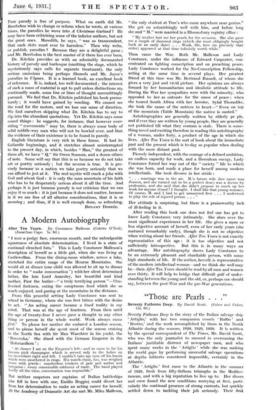A Modern Autobiography
" I HAD a podgy face, enormous mouth, and the unbudgeable squareness of absolute determination. I lived in a state of continual clenched fists." This is Lady Constance Malleson's description of herself as a little girl, when she was living at Castlewellan. From the dining-room window, across a lake, stretched the entire range of the Mourne Mountains. She would sit at dinner (one child was allowed to sit up to dinner in order to " make conversation ") with her silent determined father, the late Lord Annesley, her beautiful and kind mother, Parr the butler—" a truly terrifying person "—blue- liveried footmen, eating the sumptuous food which she so much enjoyed, and gazing at the mountains in the distance.
From this peaceful setting Lady Constance was sent to school in Germany, where she was first bitten with the desire to act " An acting career became a fixed reality in my mind. That was at the age of fourteen. From then until the age of twenty-four I never gave a thought to any other thing or person in the whole world. Work always came first." To please her mother she endured a London season, and to please herself she spent most of the season cruising in the North Sea with Sir Max Waechter in his yacht, the ' Rovenska.' She dined with the German Emperor in the Hohenzollern' :
" At dinner I sat on the Emperor's left—and so came in for his famous pink champagne which is served only to the ladies on his immediate right and left. I couldn't take my eyes off his hands which were smothered in rings. His watch-chain, too, was weighed down with jewels : numberless trinkets of jade and amber and turquoise :• every conceivable oddment of trash. The band played loudly all the time, conversation was impossible."
But neither emperors nor captains of Italian battleships (she fell in love with one, Emilio Reggio) could divert her from her determinition to make an acting career for herself. At the Academy of Dramatic Art she met Mr. Miles Malleson, " the only student at Tree's who came anywhere near genius." She got on astonishingly well with him, and before long she and " M." were married in a Bloomsbury registry office :
" My mother lent me her pearls for the occasion. She also gave me a couple of diamond rings (which she most obligingly bought back at an early date) , . . Work, life, love (in precisely that order) appeared at that time infinitely worth while.'
Then came the War. Both Mr. Malleson and Lady Constance, under the influence of Edward Carpenter, con-
centrated on fighting conscription and on preaching peace. Lady Constance worked for the No-Conscription Fellowship, acting at the same time in several plays. Her greatest friend at this time was Mr. Bertrand Russell, of whom she
gives a very just and vivid picture. Her opinions are always formed by her humanitarian and idealistic attitude to life.
During the War her sympathies were with the minority, who appealed to her as outcasts for the cause of peace ; when she toured South Africa with her heroine, Sybil Thorndike, she took the cause of the natives to heart—" Even on top of the mountain (Table Mountain) the native is ousted."
Autobiographies are generally written by elderly pe pie, and if ever they are written by young people, they are generally not published till what they contain is stale. There is some- thing novel and exciting therefore in reading this autobiography of a woman, under forty, a product of the age in which sho lives. After Ten Years is the sort of book about the immediate past and the present which is to-day so popular when dealing with the more distant past.
Fiercely independent, with the courage of a defined ambition, an endless capacity for work, and a Herculean energy, Lady - Constance forced her way out of the " society " life to which she was born, and made a place for herself among modern intellectuals. She took divorce in her stride :
" . . . marriage was in the air. M.'s future wife (her name was Joanna, and she turned out to be a perfect dear) was a doctor by profession, and she said that she didn't propose to muck up her work for anyone (Good ! I thought. I shall like that young woman ). Of course, M. and I had to get unmarried first . . . I undertook to play the role of injured person . . . "
Her attitude is surprising, but there is a praiseworthy lack of ill-feeling in it.
After reading this book one does not feel one has got to know Lady Constance very intimately. She slurs over the most significant experiences in her life. She gives a more or less objective account of herself, even of her early years (she matured remarkably early), though she is not so objective when writing about her friends. After Ten Years is not exactly representative of this age : it is too objective and not sufficiently introspective. But this is in many ways an advantage. Her autobiography shows Lady Constance to be an extremely pleasant and charitable person, with some high standards of life. If the author, herself, is representative of the modern intellectual woman—and we think she well may be—then After Ten Years should be read by all men and women over thirty. It will help to bridge that difficult gulf of under- standing between the young and the old, or, perhaps one should say, between the post-War and the pre-War generations.






































 Previous page
Previous page